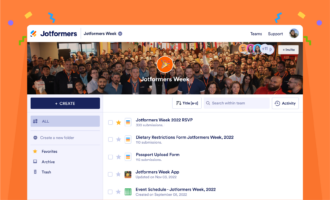Teams, collaborators, and organizers of chaos rejoice! Jotform Teams is here to transform how you use the Jotform Enterprise platform.
Jotform Teams is a new shared online workspace where Enterprise users can create and organize Jotform assets (forms, tables, reports, documents, and apps) and share those assets using role-based access controls for enhanced, secure team collaboration. Assets added to the shared workspace are owned by the entire team, keeping everyone up to date and mitigating the risk of having multiple versions of the same asset.
If you’re on one of our single-user plans, you can create a team to organize your platform assets.
Ready to scale up and invite other users to join your team? Contact Enterprise sales.
They’ll help you make the most of Jotform Teams and all of our Enterprise features.
Jotform Teams empowers teams to collaborate within Jotform Enterprise. So whether you’re creating forms, managing submissions, automating reports, designing approval workflows, collecting e-signatures, or considering how to improve team collaboration, you’ll have the resources you need in a dedicated workspace.
How customer feedback informed Jotform Teams
Many of the key features of Jotform Teams stemmed directly from customer feedback. Some customers wanted a faster way to locate and reassign forms and related data. Others wanted more options to tailor access to forms and data inside and outside their organization.
To meet these needs, we created a new team-level admin role and role-based access controls (RBAC) to improve functionality, minimize disruptions, and enhance security.
Because department heads and team leads are naturally closer to team priorities and demands, Jotform Teams enables them to monitor activity, tailor access, and reassign form ownership to optimize team performance and platform use.
Organizational-level admins can still manage and monitor all the teams for their organization from the Admin Console.
How Jotform Teams improves team collaboration
Our latest offering empowers you to create shared workspaces for teams large and small, streamlining efforts company-wide and providing unparalleled visibility for administrators and flexibility for managers. Jotform Teams offers organizations more ways to make the most of the Jotform Enterprise platform with
- Team-level administrative controls: It’s now easier than ever to find forms and transfer form ownership. Monitor team activity to adjust workloads or inform training. Share and organize platform assets and customize your team’s workspace to improve collaboration and build team spirit.
- Role-based access controls: Maximize collaboration and minimize security risks with tailored access to forms and data. Assign roles to team members — form creators, data viewers, and team collaborators — to make the most of every skill set.
- Team folders: Organize assets by project, client, resource, etc., for a shared online workspace that reflects your team’s unique goals and tasks.
- Team activity monitoring: Team members can track the latest team updates and changes to team resources, including reports, tables, forms, submission data, and more. View updates, deletions, creations, and edits at a glance right from your workspace.
- Search features: Encourage cross-department collaboration and provide greater visibility into team and organization-wide efforts with the new Teams tab. Users can search for teams that are visible to the organization, view workspaces (if permissions are enabled), and ask to join a team.
Ready to jump on the Jotform Teams train? Let’s go!
How to create a new team in Jotform Teams
Starting a team is easy. From the My Forms page of Jotform Enterprise, click Create a Team from the dropdown menu. You can also create teams from the Teams page, accessed via the Teams link in the top right navigation next to Support.
Admins can create a team from the Admin Console by clicking the Teams tab and the +Create Team button on the following page.
Next, it’s time to decide on a name for your team. Depending on the size of your organization, you may want to use a naming convention for consistency and ease of searching down the road. You can always change your team’s name in the Settings, but more on that later.
How to maintain data security with role-based access controls
Now that you have a team, invite some teammates to join you. Enter each person’s email address, setting their access level as you go. Jotform Teams offers more ways for team members to contribute with four role-based access control options.
New role-based access controls enhance collaboration and maintain security
- Team admin: The team-level administrative role in Jotform Teams enables department leaders to manage team members; move, delete, view, and edit forms; and manage form submission data. The team admin role makes it easier to analyze how teams manage data and balance user workloads. Team admins can also highlight team-specific recommendations for leveraging the platform: smart form features, task assignment and data management in Tables, apps to improve team and customer experiences, and reports to measure impact and provide visibility to customers and upper management.
- Data collaborator: These users can view forms, and view and edit data. This role is perfect for functional managers with specific tasks, such as HR and finance managers, who inform data-gathering processes and need access to data. It’s also ideal for data analysts and performance improvement professionals who can leverage Jotform Tables and Reports to share success metrics and recommendations for investment and improvement.
- Data viewer: These team members can view data with minimal risk to forms and data integrity. This role is perfect for those who need data to make decisions, process orders, and respond to customer needs but don’t need to edit data.
- Creator: Creators can view and edit forms but can’t view data. This role is ideal for supporting teams across your organization, including marketing, IT, and design specialists who can design branded forms, recommend and employ integrations, and streamline the process of form creation while ensuring brand compliance and consistency. Creators can work on forms simultaneously, making it even faster and easier to build and customize forms.
Note: You don’t need to add users to your team to allow them to fill out your form. You’ll still share your form with submitters from each form’s Publish tab.
Additional settings and editing options
Team admins can access the Team Settings menu at the bottom left corner of their Team Workspace to
- Edit the team name and custom URL
- Add or remove team members, adjust access levels, and view activity
- View team activity by date, user, and activity type
- Adjust privacy settings and set a default team member role
Add a little team spirit to your workspace by customizing the team avatar, background color, and image under General Settings. Choose from the available images and icons or upload your own.
When creating large teams, you may want to set a default team member role in Team Visibility before adding any members to save time. Here, you can also adjust access to accommodate staff changes, vacations, and promotions, and edit team visibility.
When creating a team, you can make it viewable to the entire organization or private, so that only team members can see and access it. Use the toggle switch to specify if the team’s workspace assets will be visible in addition to the team name.
Searching and viewing your organization’s Jotform Teams
Once you’ve created a team, you’ll see it listed under the My Teams tab.
Teams are visible in the left menu when viewing your forms, tables, reports, approvals, and apps.
If you want to move existing forms to a Jotform Teams workspace, select the forms on your My Forms page and drag them into the desired team listed in the menu on the left. You can also use the hamburger (three-dot) dropdown menu to the right of each form to move the form to a team. All form-related data will move with the form and be available to the team.
Additionally, you can create forms, tables, reports, and approvals directly from any Team Workspace by clicking the +Create button.
Similarly, you can move existing tables and reports to your Team Workspace; however, all of the related forms and assets will move to the specified team. The only exception to this rule is Jotform Apps. Apps can be moved to a team, and the related forms, tables, and reports will remain in the original owner’s personal workspace.
Using the Jotform Teams admin role to enhance project management
The Jotform Enterprise admin role provides access to all forms, data, and users across an organization. Jotform Teams has its own admin role, which makes it easier to manage team assets and explore new ways to achieve goals and collaborate. Organizations can assign department heads as team admins to secure forms, track activity, and optimize platform collaboration.
The admin role also makes it easy for B2B organizations, including design firms, business consultants, logistics companies, rental agencies, caterers, payment processors, market researchers, and more, to organize resources, tailor access, and securely collect and share data.
Using Jotform Teams to support cross-functional projects and affinity groups
Jotform Teams can do more than mirror your organization’s department structure. Use it to support cross-department efforts, including event planning committees, corporate development and strategic reporting, and employee resource groups.
A Harvard Business Review study showed that nearly 75 percent of cross-functional teams are dysfunctional, prompting many to ask, “What are examples of effective team dynamics?”
You can avoid common pitfalls of dysfunction by using Jotform Teams to create clear roles with accountability, share a calendar with set goals and deadlines, and centralize resources to keep communication flowing and projects on track.
Another way Jotform Teams supports cross-team collaboration is via the search feature. When a user creates a team, they can opt to make it visible to the entire organization or only to existing team members.
Making cross-functional teams and employee resource groups (ERGs) visible to your organization can increase employee engagement and reinforce a culture of belonging. A 2021 Great Place to Work study found that ERG leaders are positive about their organizations overall, and groups with 100 members or more are two times more likely to serve as a strategic resource for their organization.
Individuals can search for teams using the Jotform Teams search box. Once they’ve identified a team they would like to join, they can view the workspace and request to join the team.
Monitoring Jotform Teams from the Admin Console
Enterprise-level admins can view all the organization’s teams by clicking on the Teams tab in the Admin Console. From there, they can search by team name, select all teams, or use the hamburger (three-dot) menu to the right of each team to manage a specific team’s settings or members.
Enterprise-level admins can also take advantage of various sorting features to view and sort teams by team name, number of members, number of assets, and creation date.
Ideas and inspiration to make the most of Jotform Teams
As organizations grow and scale, staying nimble and maintaining data security can be challenging. Jotform Teams helps optimize collaboration with tailored access to data and a shared workspace for platform assets. Here are a few ideas about how to use Jotform Teams.
Human resources can share recruiting forms, use tables to track hiring targets, generate PDF contracts to collect new-hire and open enrollment signatures, build workflows to onboard employees, share reports on employee engagement and diversity, and more, all without sacrificing data security.
IT can manage equipment inventory by collecting requests for software and hardware through forms, assigning tasks in Tables to review submissions, reporting on budgets and spending, and designing workflows for purchase approvals.
Customer service can use forms to process customer queries, create internal FAQs for more consistent responses and faster response times, assign tickets via Tables, and view team activity to balance workloads and identify power users who can train recruits.
Accounting can share expense and projection forms, manage reimbursements and budgets with Tables, and process and track payments with requests for signatures and approval workflows.
Legal and compliance can house organizational contracts and policies, organize training documents, share employee and vendor certification forms, and track training and compliance status with shared tables and approval workflows.
Marketing can share branded form templates, organize project requests and kickoff forms, manage campaign calendars and assign deliverables in Tables, and automate design reviews with approval workflows.
Cross-functional teams can create custom apps to coordinate volunteer days, holiday parties, and affinity group events. They can also use performance improvement plan templates to gather ideas, as well as analyze data for more informed decisions and customize reports to share recommendations.
Event planning. Jotform actually used Jotform Teams in beta to facilitate Jotformers Week, a celebration that brings together employees from all over the world to share ideas, present solutions, and celebrate successes.
Want more ideas and inspiration? Register for the Jotform Teams webinar or visit the Jotform Teams page.
There’s a reason people love to root for teams. From exuberant alma mater matches to professional sports championships and children at play, there’s potential for glory and learning. The team at Jotform Enterprise will always be here, cheering, coaching, and celebrating your team’s accomplishments.














Send Comment:
4 Comments:
More than a year ago
Great its a nice article...,
More than a year ago
While the features are great, the scope of the new "teams" format goes beyond what small non-profits need and is cost prohibitive to small organizations. When does Jotform plan to introduce options and a pricing structure for small teams of 2-3 individuals?
More than a year ago
Are we able to assign a Team to an approval workflow vs. having to assign several individuals manually? (A painful process when there are several approvers.)
This would also facilitate adding a new user to a Team once vs. assigning the new user to approval workflows for numerous forms, which is a painful process.
More than a year ago
Use case:
Building MVP for startup. Using my jotform account to make/prototype a number of forms (contact, feedback, sign up, pdf download, etc.).
Client sees value of jotform, ready to take over management of forms, buy subscription, to get direct access to submissions, metrics, etc. (again, client is not an 'enterprise', but a startup with three people). I can only invite him as a collaborator on a form by form basis, so that's not cutting it. He can't manage any integrations as a collaborator.
There seems to be no way to transfer forms to his account.
Kinda frustrated that we started with jotform and have no graceful way of transferring forms to another account? :)
Is it all about Fortune 500, as opposed to all the small companies that build new stuff?
Thoughts?